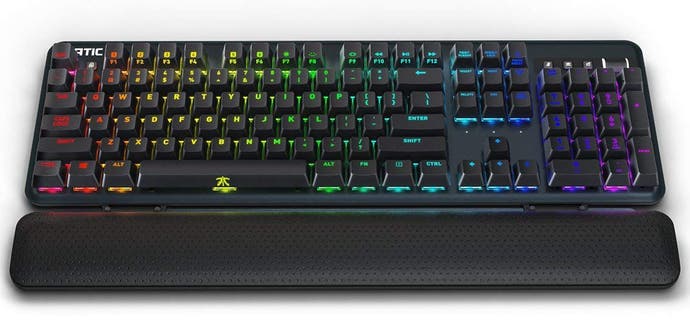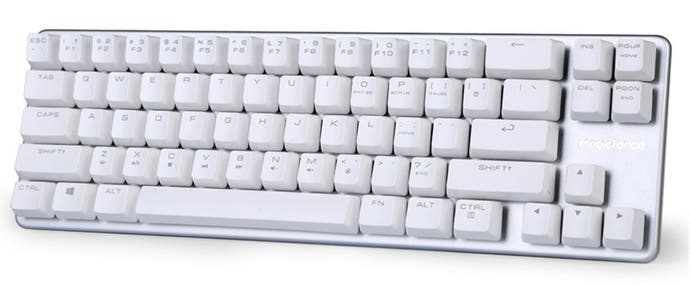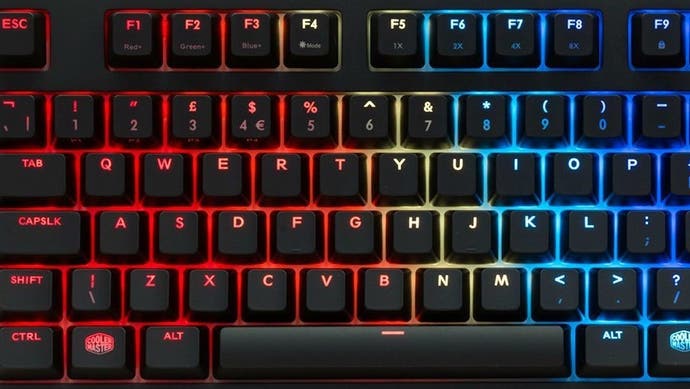Are mechanical keyboards really good for gaming?
How 'mechs' went from niche to mainstream - and which ones are worth buying.
When it comes to PC gaming peripherals, stats and specs drive purchases. Gaming monitors became popular because they offered lower latency or higher refresh rates, while gaming mice boasted higher sensitivities and improved tracking accuracy. Yet this quantitative trend doesn't seem to apply to one peripheral in particular: mechanical keyboards. No single stat separates mechs from their non-mechanical counterparts, yet mechanical keyboards are routinely recommended over alternatives that cost a fraction of the price. Why is this the case? Are there genuine gaming advantages?
The answers lie in how mechanical keyboards went from niche accessories known only to retro enthusiasts to a key part of the multi-million dollar esports industry in only a few years. By taking a closer look at this short-lived transition period, we can get a better idea of what attracted gamers to these keyboards in the first place, what quantifiable advantages they offer and which models are worth considering today.
Before mechanical keyboards were hawked by the biggest gaming brands and promoted by esports celebrities, they were a tiny niche kept alive largely by the rediscovery of artefacts from another era. For decades, enthusiasts posted their latest finds from corporate auctions or thrift stores, swapped disassembly secrets on forums and performed crude experiments to learn more about how their favourite 'mechs' were made.
As rubber dome keyboards offered the same basic functionality as expensive mechanicals at a tiny fraction of the cost, keyboards with mechanical switches were only used in retail or industrial environments where longevity mattered. However, a few small companies in the United States, Japan and South Korea used these mechanical switches to create high-end keyboards for programmers and other professional typists, who were willing to pay upwards of $100 for a keyboard that offered a better typing experience. These keyboards became popular with another class of professional as well: professional gamers, especially those based in the Mecca of esports: Seoul, South Korea.
It was here, around 2010, that games like StarCraft 2 and League of Legends first started to explode in popularity as broadcast sites like Twitch allowed gamers from around the world to tune in. Bigger gaming brands like Razer and Corsair started sponsoring pro-gaming teams, and they were quick to offer their own mechanical keyboards as well. Sales and visibility followed and within half a decade these keyboards have become standard equipment for many PC gamers.

However, it's hard to know whether mechanical keyboards became popular because they were marketed well by savvy gaming brands, or whether mechanical keyboards actually provide a genuine gaming advantage over their non-mechanical counterparts. Let's try to answer that question by looking at the first mechanical keyboards that were adopted by pro-gamers nearly a decade ago.
These keyboards were available in a few different varieties, but the most popular used Cherry MX Brown and MX Blue mechanical switches. These switches both provide greater levels of tactile feedback than non-mechanical keyboards, thanks to a bump that occurs when the key is pressed down about halfway. That bump tells you exactly when the key press has been registered, and allows you to quickly move onto other keys. The MX Blue switch goes further, requiring a little more force to push, but providing an audible click as further feedback. Keyboards with these switches were popular with typists because they allowed for faster, more accurate typing and these same advantages translated well into strategy games like StarCraft which required incredibly fast and accurate key presses for players to compete at a high level.
Another advantage common to both typists and gamers was that of dependability. The rubber dome in non-mechanical keyboards hardens over time, requiring an increasing amount of force to register a key press. While rubber dome keyboards might be rated for fewer than 10 million key presses, mechanical keyboards are rated for more than 50 million. Even 10 million key presses sounds like a lot, both professional typists and professional gamers might reach that figure within a few years - in fact, some professional StarCraft gamers in Korea needed to replace their rubber dome keyboards every few months. That might make mechanical keyboards a more economical choice over the long term, especially if you value consistent performance.
Additionally, mechanical keyboards often featured a diode on each key, something not possible for manufacturers to include on rubber dome keyboards. That meant that the rollover count of the keyboard - the number of keys that could be correctly recognised simultaneously - was higher than non-mechanical alternatives. Older mechanical keyboards that used the PS/2 connector could recognise as many simultaneous key presses as there were keys on the keyboard, while USB keyboards were limited to six-key rollover. In contrast, many rubber dome keyboards top out at two-key rollover, with combinations like Q, X and C often not working as intended. Not many typists need to press more than a couple of keys at a time, but it's very helpful for fast-fingered gamers - especially those playing shooters like Counter-Strike or rhythm games like Osu.
The high cost of mechanical switches also popularised smaller keyboard form-factors which could be offered at a lower price. Tenkeyless keyboards, so-named because they omit the ten keys of the number pad, were popular with many StarCraft players because they allow the mouse to be held in a more comfortable position in line with the shoulder. This can reduce strain on the neck, shoulders and back, making them worth considering as long as you don't play games that regularly use the number pad.
Essentially, mechanical keyboards were popular with these influential group of pro-gamers because they offered better tactile and auditory feedback, lasted longer and could correctly recognise a large number of key inputs at once. While gaming brands certainly pushed mechs into the mainstream, mechanical keyboards justified their rapid expansion with some genuinely helpful features. However, it is telling that many of the biggest trends in mechanical keyboards today - backlighting, macro keys and game-state integration - weren't present in these early models. Instead, it was all about the basics: a well-built keyboard that felt great to use and could be customised to make your own.
Our recommendations include some models with these later features and some without, but all come with at least six-key rollover, MX mechanical switches and the option for a compact layout. For a more complete lineup, please see our up-to-date recommendations for the best mechanical keyboards in 2018.
The best mechanical gaming keyboard: Fnatic Streak Pro - £120

The Fnatic Streak is a full-fat mechanical keyboard for gaming that includes many of the extra features that some users like, such as a detachable faux-leather wrist rest, full RGB backlighting, a programmable layout and a dedicated volume knob. It gets bonus points for customisability, with a choice of MX Red or MX Brown switches plus full-size and tenkeyless versions. Like the other keyboards we're recommending, it also comes with a standard layout which makes finding replacement keycaps a cinch, unlike other popular keyboards from Razer and Corsair.
The best cheap mechanical gaming keyboard: Qisan Magicforce - £30/$40

This budget keyboard has become a popular choice for newcomers trying out a mechanical keyboard for the first time. The £30 price point is achieved through a compact 68-key layout, which omits dedicated F keys and a number pad, but retains the arrow keys. Combined with the MX Brown switches, you get a great typing feel thanks to the tactile feedback, without the loud click of MX Blue switches which might annoy your deskmates. The keyboard doesn't come with any backlighting, but the standard (if compact) layout does allow for custom keycaps to be installed easily if white isn't your peripheral colour of choice. Overall, an excellent keyboard that makes sensible sacrifices to achieve its bargain basement price.
The best value mechanical gaming keyboard: Cooler Master MasterKeys Pro S - £92/$120

The MasterKeys Pro S comes in an ergonomic tenkeyless layout with RGB backlighting. The board comes with a choice of tactile MX Brown or linear MX Red switches in most regions and is well-built with a clean, minimal design. Other gaming-centric features, like macro recording, are also present, although there are no dedicated keys for this functionality. You can also get cheaper variants with white LED backlighting or more durable PBT keycaps.
Mechanical keyboards have endured an interesting trajectory, from their historic origins to their underground period, and now back to the mainstream once again on the backs of a few small keyboard companies, dedicated mech enthusiasts and StarCraft II pro gamers. Since then, mechanical keyboards from the gaming brands have accumulated a laundry list of features to match their premium price tags - some genuinely useful, like dedicated media keys or game-specific backlighting, and others of more dubious value, like proprietary switches (that won't accept standard keycaps), underglow lighting or cloud connectivity.
Thankfully though, budget boards offering real mechanical switches and little else in way of features have become more affordable than ever, making it possible for almost anyone to afford a mechanical keyboard. No matter what your requirements, chances are there's a mech out there with your name on it.









